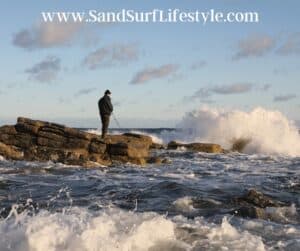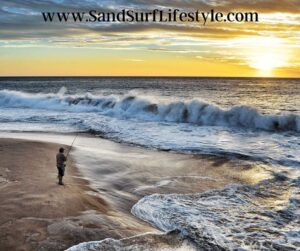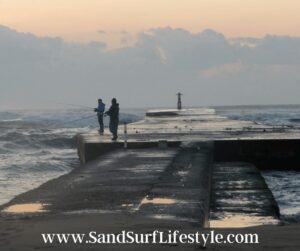I have always found that one of the most exciting aspects of surf fishing is the wide array of species you can catch. According to the website oceana.org, the world’s oceans are home to over 20,000 different species of saltwater fish. Of course, different species of saltwater fish tend to dwell in different parts of the ocean. If you want to catch a myriad of different fish, you are going to need to know where they are located. This means that you are going to have to know not only where to cast your line, but also how far out you will need to cast.

Location of Cast
Oceans are composed of several different zones in which different species of saltwater fish like to gather, per Fish From Beach. Several different factors determine which species of fish gather in these zones. A few of these determining factors are the surf conditions; the weather conditions; the structure of the beach; and the time of day. Knowing where to cast your line when surf fishing can be the difference between catching more fish than you can handle, or going home empty-handed.
Saltwater fish typically spend most of their time on the shoreside and the seaside of the sandbar. Most beaches typically have two to three sandbars that separate the coastline from the open ocean.
Sandbars are bars of sediment and sand that run parallel to the shoreline and can be identified by spotting the white waters that break while rolling above them. These waves can easily be identified by their white color, which is caused by the sandbar forcing the waves to rise and crash back into the ocean. Once you have spotted where the sandbar is located, the second spot you should be able to identify is the trough. These are the deep, dark waters between the sandbars, and are widely known as the best place to cast your line when surf fishing.
Saltwater fish can also be found in the areas where the rip current heads seaward. Larger fish tend to feed on smaller and medium-sized fish in this area, which makes it the perfect area of the ocean to land your calves if you are looking to catch large saltwater fish. The fact that larger predatory fish like to stalk their prey in these areas, coupled with the fact that smaller to medium-sized fish feel comfortable in these areas, makes fishing between the sandbars the top location to cast your line amongst the world’s best surf fishing anglers.
Distance of Cast
 Most species of larger fish like to gather in schools farther away from the shoreline. However, according to Teach Me Surf Fishing, not all of the bigger species of fish tend to dwell over 100 yards from the coast. Some larger species of saltwater fish like to swim in areas that are 50, 60, or even 70 yards away from the shore. Depending on who you ask, surf fishermen will tell you that you need to be able to cast your line anywhere between 20 and 100 yards away from the coast to have a successful day fishing.
Most species of larger fish like to gather in schools farther away from the shoreline. However, according to Teach Me Surf Fishing, not all of the bigger species of fish tend to dwell over 100 yards from the coast. Some larger species of saltwater fish like to swim in areas that are 50, 60, or even 70 yards away from the shore. Depending on who you ask, surf fishermen will tell you that you need to be able to cast your line anywhere between 20 and 100 yards away from the coast to have a successful day fishing.
Contrary to popular belief, you do not need to be able to cast your line as far as possible to be successful in surf fishing, according to the Surfcasting Republic. I have found that the best results come from casting your line anywhere between 50 and 100 yards from the shore. This area of the ocean is the preferred feeding ground of many species of saltwater fish, and can usually be spotted by patches of brown water amongst the otherwise bluish-green ocean. Most fish like to feed in this general area because it is far enough out to avoid commotion caused by beachgoers, but close enough for the waves to bring in crustaceans and other tasty treats for the fish.
One aspect of long-distance casting that is often overlooked is simply known as the trial-and-error method. This method consists of casting your line as far as you can, and then slowly reeling it in until you notice that you are getting a bite. It is of the utmost importance that you pay attention to the specific area where you notice that first bite, as this will be the area where the most fish are gathered. This will not only give you a good idea of where the fish are located, but it will also give you an approximate distance of how far you should be casting your line.
What Size Sinker Should You Use for Beach Fishing? Find out here.
Ocean Break
The ocean’s break conditions will not only give you a good idea of when the best time to fish is, but it will also let you know where you should cast your line when surf fishing. Some of the best surf fishing occurs when break conditions are rough, and being able to cast into that break will give you an advantage in reeling in more fish. Because rough brake conditions provide many different species of saltwater fish with camouflage that allows them to move closer to the shoreline, these fish will be much more likely to take your bait.
Rough break conditions also tend to stir up more food from the ocean floor, causing a feeding frenzy amongst saltwater fish. Larger predatory fish and also be found near rough break conditions because these conditions are known to disorient smaller, bait-sized fish that these larger species usually prey on. While it is fairly easy to spot rough break conditions in the ocean, they are most frequently seen when weather conditions are less than ideal. Surprisingly, fish can sense changes in the weather and do not like to feed when atmospheric pressure is low.
Saltwater fish have an innate ability to sense the changes in atmospheric pressure often associated with bad weather conditions. A fish’s bladder will expand when the atmospheric pressure is low, while it will contract when atmospheric pressure is high. Why is this significant? Rough break conditions are often associated with inclement weather conditions, which is when most feeding occurs with larger saltwater species of fish.
Tide Conditions
I have previously discussed the importance of being able to locate sandbars when casting your line during a surf fishing trip. The conditions of the tide play a significant role in being able to spot where the sand bars are located, as they are easier to find during low tide conditions. However, low tide is generally known as being the worst time to go surf fishing. The shallow waters that are associated with low tide make it dangerous for fish to come close to the shore, which makes them much more difficult to catch. Optimal surf fishing conditions require high tide, and for the water to be moving rapidly.
 This makes fishing during high tide the best time to surf fish, and knowing where to cash during high tide is crucial to your success. The best tide condition in which to surf fish is when the water appears to be moving best. This is typically found either an hour before or an hour after high tide. Spotting tide conditions is fairly easy, as the water is farther away from the shore during low tide conditions, while it is closer to the shore during high tide conditions.
This makes fishing during high tide the best time to surf fish, and knowing where to cash during high tide is crucial to your success. The best tide condition in which to surf fish is when the water appears to be moving best. This is typically found either an hour before or an hour after high tide. Spotting tide conditions is fairly easy, as the water is farther away from the shore during low tide conditions, while it is closer to the shore during high tide conditions.
It is not uncommon for novice anglers to take a while to acquire the skills and knowledge it takes to be successful. However, being able to spot tide conditions is one of the easier tasks to master in the sport of surf fishing. Many surf fishing anglers use the following methods to determine the best time to fish according to the tide conditions:
● Newspapers and magazines
● TV
● Mobile applications
● Websites
● Marinas and ports announcements
The sun, moon, and position of the planet also factor greatly in the condition of the tide. Most surf fishermen will tell you that the best tide conditions to fish are during Spring high tide. During this time, you are afforded a two-hour window before or after high tide and which two fish, instead of the usual one-hour window.
Conclusion
 It has been my experience that several things factor into whether your day of surf fishing will be a day of fun or a day of frustration. You will need to be able to cast your line at the perfect spot, which is located between the first and second sandbar. You will also need to know how far to cast when surf fishing. I have found that the best spot to cast is between 50 and 100 yards from the coast. Rough break conditions are the best break conditions in which to fish, and being able to cast directly into these break conditions is essential to successful surf fishing.
It has been my experience that several things factor into whether your day of surf fishing will be a day of fun or a day of frustration. You will need to be able to cast your line at the perfect spot, which is located between the first and second sandbar. You will also need to know how far to cast when surf fishing. I have found that the best spot to cast is between 50 and 100 yards from the coast. Rough break conditions are the best break conditions in which to fish, and being able to cast directly into these break conditions is essential to successful surf fishing.
Finally, the condition of the tide is a key element in saltwater angling. The best surf fishing is known to occur during high tide, and there are many different means of determining when high tide will happen. Although I do consider surf fishing to be a passion, it is a rather complicated sport. However, I find that when I can combine the techniques, skills, and knowledge I have acquired in conjunction with the optimal tide, break, and weather conditions, there is nothing more rewarding than reeling in a trophy-sized saltwater fish.
Please note: This blog post is for educational purposes only and does not constitute legal or medical advice. Please consult a legal expert or medical professional to address your specific needs.

